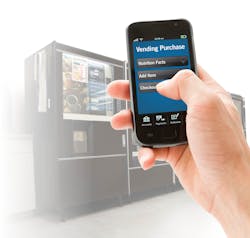I recently asked a relative of mine whether or not he is using mobile payments. He is 18, just about to go to college. He has an iPhone 6 that allows for Apple Pay. But he doesn’t use a mobile wallet because he doesn’t want to take the time to set it up. “Besides,” he told me, “I have my debit card.”
This is interesting to me. Apple Pay launched in October, joining other mobile wallets like Google Wallet Softcard. Since then, the beat of the mobile wallet drum has gotten louder. Thousands (hundreds of thousands) of stores and even vending machine and micro market manufacturers have come out boasting that they accept Apple Pay and other mobile wallets. This year at the NAMA OneShow mobile was a strong topic of conversation, said to transform the industry. Millennials are said to be pushing this trend towards mobile and the national media are running headlines like “Millennials Abandon Cash For Mobile Payment Apps.” This got me thinking about the “recent” boom of the mobile wallet. Are Millennials truly making the switch and is it as fast as we all think? We all jumped on the mobile bandwagon initially, but are we just kidding ourselves?
Strong evidence for mobile
In April the Pew Research Center found that 64 percent of American adults own a smartphone of some kind, up from 35 percent in the spring of 2011. In a survey, Fico found that twice as many Millennial respondents (32 percent) report that they are likely to use mobile wallet services like Apple Pay or Google Wallet in the next 12 months as those who are 35 and older (16 percent). Additionally, 56 percent of younger Millennials (18-24) report that they are already using or very likely to use alternative payment services like Venmo and PayPal. Reports do not exist on the dwindling number of mobile users, that’s for sure. Mobile wallet usage is trending upwards.
That includes in our own industry as well. During her OneShow opening remarks, NAMA CEO Carla Balakgie had a technology focused message. She discussed the importance of offering cashless options at the machine, saying at one point that cashless would give operators a nearly 21 percent increase in sales over other operators. “Keeping up with technology is today’s cost of doing business,” she said. “Every deferred opportunity puts you further behind the competition.”
All around us
Mobile is part of everyday life for most, with instant access to the weather and sports updates, getting a taxi home and checking bank accounts among a plethora of other uses (calling, for instance). Some states even allow for proof of insurance to be stored on a driver’s smartphone. The state of Iowa will launch a digital driver’s license soon (and won’t be the only state to do so), making the smartphone even more valuable and useful to consumers. Everything is moving to the smartphone and although mobile wallet integration might not be as immediate as we thought it would be when Apple Pay launched with fervor last fall, we aren’t kidding ourselves. Mobile is not just a trend in any industry. It’s a consumer lifestyle evolution that can’t be ignored anywhere, even in vending.

Adrienne Klein | Contributing Editor
Adrienne Zimmer Klein is a freelance writer with a background in the vending, micro market and office coffee service industry. She worked as an associate editor and managing editor at Automatic Merchandiser and VendingMarketWatch.com from 2013 until 2017. She is a regular contributing writer at Automatic Merchandiser.





